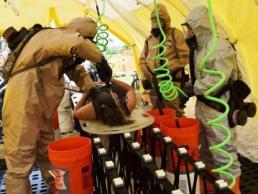Story by: 1st Lt. Matthew Verdugo
Posted: December 9, 2015
 1st Lt. Matthew Verdugo
1st Lt. Matthew Verdugo
Soldiers from the 436th Chemical Company, 6th CBRNE Enhanced Response Force Package, 136th Maneuver Enhancement Brigade, Texas Army National Guard, decontaminate a volunteer at the San Marcos municipal airport during a simulated plane crash exercise, Nov. 16, 2015. (U.S. Army National Guard photo by 1st Lt. Matthew Verdugo/Released)
BASTROP, Texas – National Guardsmen of the 436th Chemical Company conducted dual-mission training exercises at Camp Swift near Bastrop, Texas, and San Macros, Texas, during their annual training period Nov. 13-18, 2015.
The soldiers practiced their traditional warrior skills at Camp Swift, Texas, in areas such as land navigation, security clearing, basic rifle marksmanship, machine gun familiarity, reacting to improvised explosive devices, and physical fitness. This training is essential to maintaining a state of readiness and deployability in support of the citizens of Texas and civil authorities at home or abroad.
“It is always important to return to basics and improve upon warrior tasks and drills that lay the foundation for everything we do as soldiers,” said 1st Sgt. Dianne Overshown, first sergeant for the 436th Chemical Company. “In many cases, our Soldiers can bring valuable insight from their civilian careers to enhance the training the unit receives in the field.”
The 436th Chemical Company’s core mission is to decontaminate friendly units that have come under a chemical, biological, radiological or nuclear attack in theaters of operation. In addition, the unit specializes in the reconnaissance of CBRN threats and the surveillance of biological dangers. However, their basic Army fundamentals are the foundation that allows the unit to excel in their more technical responsibilities.
“It was fascinating to see some of our soldiers with law enforcement backgrounds take the lead on room clearing and marksmanship,” said Sgt. 1st Class Stephen Snyder. “Training like this really gives the soldiers confidence for future, more complex operations.”
Experienced leaders shared their lessons and best practices with subordinates throughout the week, refining team skill sets in reacting to IEDs, clearing buildings, and weapon familiarization. Each drill reinforced the common themes of teamwork and cooperation.
“It was great to shoot rounds down range and learn from our experienced sergeants some of the finer points of marksmanship,” said Spc. Zacharias Trigo. “I never realized the infinite number of situations that could present themselves during the clearing of a building and how all team members must work as one.”
The service members also practiced mass casualty decontamination operations as part of their FEMA Region VI Homeland Response Force mission. The HRF mission calls for Guardsmen to augment first responders during stateside natural or man-made disasters requiring specialized decontamination capabilities.
“Our unit has the unique challenge and privilege of being able to help our fellow citizens in a time of crisis,” said 1st Lt. Luis Lopez, 436th Chemical Company commander. “We train, hoping that a day like that never materializes. It is training like this that makes it real for everyone involved.”
The 436th Chemical Company additionally participated in a simulated downed plane scenario at the San Marcos Municipal Airport alongside area first responders and other elements of their National Guard battalion, the 6th CBRN Enhanced Force Package. The exercise simulated dozens of casualties and the release of toxic elements in and around the crash site. The chemical soldiers practiced setting up the decontamination infrastructure and conducting mass causality decontamination while wearing personal protective equipment.
“Exercises like this really bring to light the responsibility our unit has to help our fellow citizens survive such a potential tragedy,” said Staff Sgt. Vanessa Stange. “I am amazed by the professionalism of the area first responders and how our soldiers are performing under stress.”
In addition to the simulated plane crash, 436th Chemical Company soldiers were certified during a three-day course as hazmat operators and recognized by the National Guard Bureau as qualified to perform their decontamination duties. This gives the troops an academic component to augment their practical application exercises throughout the year.
“Having two missions is a lot of work, but it is rewarding and feels good that we can help,” said Spc. Katty Gracia. “I can’t wait until the next annual training.”